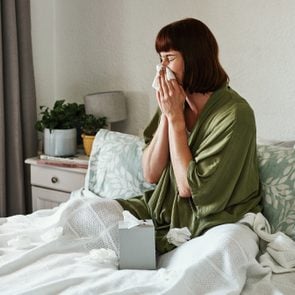A Guide to Allergy Symptoms, Causes, and Treatments
Updated: Oct. 10, 2022
Allergies making your life miserable? Here's what you need to know about them, including the causes, symptoms and treatments for allergies.
What causes allergies?
Allergies are an incredibly common health condition that impact more than 50 million Americans each year.
An allergy occurs when your immune system comes into contact with an allergen—a foreign but typically harmless substance, like pollen—that triggers an immune reaction.
An allergen can be something you eat, inhale, put on your skin or body, or touch. It can make you cough, sneeze, break into hives or a rash, or even complicate your breathing.
In extreme cases, an allergic reaction can close airways and drop blood pressure, which can be potentially life threatening.
While there are many different types of allergies, the most common ones are mediated by an antibody called immunoglobulin E, or IgE, explains Gary Soffer, MD, pediatric allergist with Yale Medicine.
“Most commonly allergies are triggered by protein substances such as those found in pollen or foods,” adds Dr. Soffer.
According to the Asthma and Allergy Foundation of America, allergies are the 6th leading cause of chronic illness in the United States. Allergies can lead to conditions like asthma.
Allergy symptoms tend occur after your immune system becomes sensitized to a particular allergen, says Purvi Parikh, MD, an immunologist with Allergy & Asthma Network.
“When the body comes into contact with these substances it triggers a response through IgE that activates allergy cells like mast cells and basophils which then cause the cascade of symptoms throughout the body,” he says.
Unfortunately, allergies are on the rise. Some experts believe it may be due to the over-sanitization of the modern era, which results in people having less exposure to germs, parasites, and other infections than previous generations.
Known as the hygiene hypothesis, this may cause the immune system to go down a pathway where it’s more likely to overreact to otherwise harmless substances.
While there is no easy cure for allergies, there are some ways to prevent the reactions, treatments to help with the symptoms, and strategies to reduce their impact.

What are the most common causes of allergies?
There are various types of allergies, each with specific causes, symptoms, and treatments.
Food allergies
Dr. Parikh explains that any type of food can be an allergen. However, the most common food allergies are to eggs, peanuts, tree nuts, milk, wheat, dairy, soy, fish, and shellfish.
People with food allergies must check ingredient lists and avoid the specific ingredients that trigger an allergic reaction.
A doctor may recommend that some people carry an epinephrine autoinjector (EpiPen) at all times. The drug epinephrine can help reverse the most dangerous allergic reaction, known as anaphylaxis. (More on that later.)
Insect bites
There are a number of insects that can provoke an allergic response. Dr. Parikh explains that some people have a venom allergy (bees, wasps, hornets), which can be life threatening.
“They must carry an EpiPen,” she notes.
Mosquitoes and fire ants also can also cause allergic reactions, but these may be less dangerous. Treating these types of allergic reactions involves a combination of antihistamines, topical creams, and ice for swelling.
Drug allergies
You can be allergic to any drug, but ones administered with injection or IV are more likely to trigger an allergic reaction. IV drugs are more likely than others to trigger severe reactions, like anaphylaxis.
In general, symptoms of a drug allergic reaction can include a rash with or without other symptoms such as nausea, vomiting, diarrhea, and shortness of breath.
Treatment involves strict avoidance of the medication and possible desensitization if the individual absolutely needs the drug.
Respiratory or environmental allergies
Respiratory allergies, also known as hay fever or allergic rhinitis, are typically reactions to airborne allergens like dust mites, pollen, and cat and dog dander.
The symptoms can include itchy, watery eyes, nasal congestion, asthma (including coughing, wheezing, and shortness of breath) as well as skin rashes.
Treatments for these kinds of environmental allergies vary widely based on symptoms, but Dr. Parikh suggests anyone with these type of allergy symptoms see a board-certified allergist.
“Asthma management is different from sinusitis vs. conjunctivitis,” she points out.
Skin allergies
Skin allergies can be a rash, hives, eczema, and others that are triggered by a food, chemical (ingredient in a product), or environmental allergen, explains Dr. Parikh.
Treatment is dependent on the type of rash, how severe it is, and the cause.
One way to figure out if you are allergic to a specific skin or hair care product is to do a patch test.
However, it’s not always easy to figure out the source of skin rashes or hives. You can get hives for no reason, known as chronic idiopathic urticaria, or in response to cold temperatures, pressure on the skin (known as skin writing), the sun (known as solar urticaria), or stress.
What is anaphylaxis?
Anaphylaxis is the most severe manifestation of an allergy and most commonly occurs with food allergies or stinging insect allergies Dr. Soffer explains.
Symptoms can include diffuse hives, swelling, difficulty breathing, vomiting, and a severe drop in blood pressure.
“Patients in anaphylaxis can die from their allergy if not treated in an appropriate and timely manner,” he notes. Dr. Parikh adds that it can involve multiple organ systems.
As we mentioned, epinephrine (also known as adrenaline), can quickly counteract swelling and other symptoms that occur during an anaphylactic reaction—emergency medical treatment is necessary.
Chronic conditions and health problems linked to allergies
There are multiple health conditions linked to allergies, explains Dr. Parikh.
They include:
- Allergic asthma
- Allergy-related headaches/migraines
- Insomnia
- Hives
- Eczema
- Sinusitis
- Allergic conjunctivitis, an inflammation of the eye’s lining
- Oral allergy syndrome, which is a when people who are allergic to pollen have an itchy or tingling lips and throat when they eat certain fruits and veggies, due to a cross reaction
- Eosinophilic esophagitis, a chronic immune problem where white blood cells congregate and damage tissue in the esophagus, sometimes due to allergies, which can lead to difficulty swallowing.
Diagnosing allergies
Allergic rhinitis (environmental allergies), food allergies, and reactions to stinging insect allergies are all initially evaluated with a careful history.
“If that history is suggestive of an allergic reaction then skin testing or blood testing is often performed,” says Dr. Soffer.
Food allergy testing should never be performed without a clear clinical history of a reaction, and only specific foods of concern should be evaluated, he says.

Allergy tests
There are a few different types of allergy tests, depending on the allergy in question.
Skin prick test
The skin prick test involves an allergist pricking the skin and placing a small amount of the potential allergen in the area so it can get beneath the skin.
If there is an allergy, a red, itchy bump will likely appear.
Blood test
In a blood test, you will be tested for IgE antibodies, the antibodies produced by the immune system when exposed to an allergy-causing substance.
The presence of IgE antibodies suggests that the body recognizes a substance as a potential allergen, but it doesn’t mean you necessarily will have symptoms when exposed to it.
Oral challenge test
This type of test is performed less often because it involves an allergist administering small amounts of a food allergen via capsule or with an injection.
You will then be closely monitored for a reaction. If you have one, you can be promptly treated, but if you do not, it can help definitively rule out a specific food allergy.
At-home allergy tests
At-home tests involve taking a sample of blood yourself—either in a lab or sometimes by applying a drop of blood to paper in a kit—and then sending the sample off to be analyzed.
While at-home tests may seem convenient, Dr. Parikh and Dr. Soffer strongly advises against home test kits as they often lead to misdiagnosis of allergy.
Other reasons to consider avoiding them are that they aren’t regulated by the Food and Drug Administration (FDA), the results may not be clear, and they can be expensive.
“You need to be trained in interpretation and can misdiagnose yourself,” Dr. Parikh says. “Also, many of at home tests are not standardized or evidence based.”
Allergy treatments
Depending on the type of allergy you have (environmental, food etc.), an allergist has several different treatment options that they will tailor to the individual patient, explains Dr. Soffer.
Environmental controls
Environmental controls, such as checking the pollen count and minimizing time spent outdoors during allergy season, avoiding pet dander, and keeping your home clean and free of mold, dust, smoke, and pests like mice and cockroaches, can be incredibly helpful in minimizing allergies, says Dr. Parikh.
Other steps you can take can include swapping out air filters (preferably HEPA) as recommended, using air purifiers in your home, changing bed linens often, opting for hypoallergenic dogs and cats (or no pets at all), using special mattress and pillow covers, and buying hypoallergenic products when available.
Immunotherapy/allergy shots
Immunotherapy/desensitization is a common method of treating allergies, namely allergic rhinitis (hay fever), asthma, and eczema.
Immunotherapy can look like allergy shots, which involve injecting an extract of the allergen into the arm of a patient, or treatment with drops in the mouth.
It can be helpful for people suffering from long-term allergies, as they are the only treatment that can actually desensitize the immune system to prevent allergies from occurring.
They work better for some types of allergies than others and can involve a long-term commitment to the treatment over time.
Medication
There are various medications, both prescription and over-the-counter, to help treat allergy symptoms.
“One common misconception is that allergic rhinitis is best treated with oral antihistamines,” says Dr. Soffer. “In truth, the best and primary treatment is steroid nasal sprays,”
Here are just a few of the allergy medications you can try over-the-counter or via prescription, including antihistamines and steroid nasal sprays:
- Zyrtec (cetirizine)
- Claritin (loratadine)
- Benadryl (diphenhydramine)
- Xyzal (levocetirizine)
- Allegra (fexofenadine)
- Rhinocort (budesonide)
- Flonase (fluticasone propionate)
- Nasacort (triamcinolone)
Allergy prevention
Dr. Soffer maintains that one of the most important ways of preventing allergies from developing is exposing children to allergenic foods as early as possible.
“We know that in children who have a high risk of developing peanut allergy, by introducing peanuts at four to six months [of age], parents can dramatically reduce the risk of peanut allergy,” he says.
Dr. Parikh recommends that you should try to reduce exposure to air pollution as well as avoid over-sanitizing with chemicals.
Products that may help reduce allergies
There are a variety of products on the market that can help prevent or minimize allergies:
- The 7 Best Nasal Sprays for Allergies
- 8 Air Purifiers for Better Air Quality, According to Allergists
- 10 Products That Help You Get Rid of Dust Mites
- 7 Best Hypoallergenic Pillows for People With Allergies
- 6 HEPA Filter Vacuums for People With Allergies
- 7 Best Air Purifiers for Mold, According to Experts



